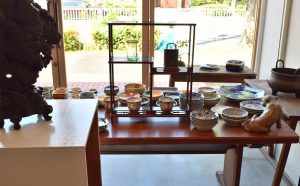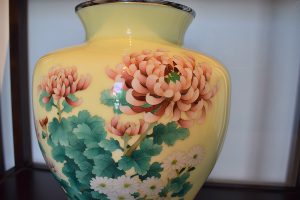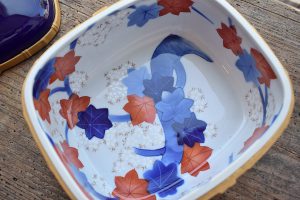花言葉のはじまりは…(愛知県千種区姫池通 買取いたします 古美術風光舎名古屋店)
2021.08.28
皆さま、こんにんちは。
Hello everyone.

ここ古美術風光舎名古屋店では、店内に色々な骨董品が置いてあるのですが、その中でも花が数多くあります。
花鳥風月という四字熟語があるように、花はモチーフとして多く使われているのですね。
ですから今日は、店内にある花を紹介していけたらなと思います。
ところで疑問に思ったのですが、花には花言葉というものがありますが、これはいったいどこから発生して、どうやって決まっているのか…。
高校時代には、花を描いて作品のタイトルにその花の花言葉をつける人もいましたし、人に花を贈るときも、花言葉を考えて花を選んだりしますよね。花言葉の本なども発売されていたり、花の見た目だけではなく、花言葉も重要視されています。
もうただただ気になってしまうので、これは花を紹介する前に調べるしかないと思い、調べて参りました。
花言葉は、トルコの「セラム」といわれる風習がはじまりだそうです。
花や果物に詩句がついており、それらを送ることで相手に自分の気持ちを伝えるそうです。
1818年、パリで初めて花言葉の書籍、花言葉辞典なるものが出版されました。
これは、シャルロット・ド・ラトゥールという方が執筆したのですが、彼は花言葉をつける際に2つの事を元にした手法で決めたそうです。
1つ目は、「その植物の外形や香り・色・生態といった植物の性質・特徴を言葉で表現しようとする観察重視の姿勢」
2つ目は、「西欧社会で草花が積み重ねてきた文化史的伝統を、一つの単語に凝縮して形容しようとする文化史重視の姿勢」。
そして、この本は当時ものすごく人気が出たそうです。重版を繰り返し、海賊版も出たほどです。
もちろんそれは日本にもやってきました。
明治初期頃輸入され、当初は輸入された花言葉をそのまま使っていたそうですが、その後、日本独自の花言葉も盛んに提案されるようになったそうです。
このようにして、花言葉は世界へ広がっていったようです。
そして、まだまだ植物は新種が開発されていますが、新しい花が出来た場合、それらには開発者自身が花言葉をつけたり、消費者から募集したりすることもあるそうです。
素敵な花言葉をつければ、販売促進効果もありそうですね。
現在は、花言葉を公式に認定する機関はないそうです。
また、日本と海外では、国の歴史や風習が異なるように花言葉も全く違う場合があるので、もし花を贈る時は気をつけなければなりませんね。
それでは風光舎名古屋店の花たちを3つほど、写真とともに紹介していきますね。
Here at the antique Fukosha Nagoya store, there are various antiques in the store, but among them there are many flowers.
Flowers are often used as a motif, as is the case with the four-character idiom Kacho Fugetsu.
So today, I would like to introduce you to the flowers in the store.
By the way, I was wondering, but there is a flower language in flowers, but where exactly does this come from and how is it decided?
When I was in high school, some people drew flowers and added the flower language to the title of the work, and when giving flowers to people, they also think about the flower language when choosing flowers. Books on flower language are on sale, and not only the appearance of flowers but also flower language is regarded as important.
I’m just curious about this, so I thought I had to look it up before introducing the flowers, so I’ve been looking it up.
The flower language is said to have started with the custom called “Serum” in Turkey.
Flowers and fruits have poems, and by sending them, you can convey your feelings to the other party.
In 1818, the first flower language book, the Flower Language Dictionary, was published in Paris.
This was written by a person named Charlotte de Latour, who seems to have decided on a method based on two things when adding flower language.
The first is “an observation-oriented attitude that tries to express the nature and characteristics of the plant in words, such as the outer shape, aroma, color, and ecology of the plant.”
The second is “a stance of emphasizing cultural history, which attempts to condense and describe the cultural history traditions that flowers have accumulated in Western society into a single word.”
And this book seems to have become extremely popular at that time. Reprints were repeated, and even pirated editions were released.
Of course it also came to Japan.
It was imported in the early Meiji era, and it seems that the imported flower language was used as it was at the beginning, but after that, Japanese original flower language was also actively proposed.
In this way, the flower language seems to have spread to the world.
And, although new species of plants are still being developed, when new flowers are created, the developers themselves may add flower words to them or recruit them from consumers.
If you add a nice flower language, it will have a sales promotion effect.
Currently, there seems to be no official certification body for flower language.
Also, in Japan and overseas, the flower language may be completely different as the history and customs of the country are different, so you have to be careful when giving flowers.
Then, I will introduce about three flowers of Fukosha Nagoya store with photos.

まずはこちら、「桔梗」の豆皿です。
桔梗の花言葉は「永遠の愛」「変わらぬ愛」です。
恋人を一生待ち続けた若い娘の物語からこの花言葉が付けられたそうです。
First of all, here is the bean dish of “Kikyou”.
The flower language of Kikyo is “eternal love” and “unchangeable love.”
It is said that this flower language was given from the story of a young girl who had been waiting for her lover for the rest of her life.

こちらは「菊」。
色々な所で使われる菊なので、もしかしたらご存じの方もいらっしゃるかもしれませんが…。
主な花言葉は「高貴」や「高尚」です。
菊は気品のある美しい花を咲かせることで古くから親しまれており、天皇家の家紋としても使われていることから、この意味が付けられました。
しかし、どの花でもそうなのですが、色によって花言葉が変わってきます。
菊の場合だと…
赤い菊は「あなたを愛します」「愛情」
黄色い菊は「破れた恋」
白い菊は「真実」「誠実」
紫の菊は「恋の勝利」「夢が叶う」
ピンクの菊は「甘い夢」
緑やオレンジの菊は、特に定められていないようです。
こんなに色があることにも驚きましたが、色で意味がこんなに変わるとは知りませんでした。
This is “chrysanthemum”.
It’s a chrysanthemum that is used in many places, so maybe some of you may know it …
The main flower words are “noble” and “noble”.
Chrysanthemums have long been popular for their elegant and beautiful flowers, and are also used as the family crest of the Emperor’s family, giving this meaning.
However, as with any flower, the flower language changes depending on the color.
In the case of chrysanthemums …
The red chrysanthemum “loves you” “love”
The yellow chrysanthemum is “torn love”
White chrysanthemum is “truth” “honesty”
Purple chrysanthemum is “victory of love” “dream comes true”
Pink chrysanthemum is a “sweet dream”
Green and orange chrysanthemums do not seem to be specified.
I was surprised that there were so many colors, but I didn’t know that the meaning would change so much with colors.

最後に「もみじ」です。
花だけでなく、葉っぱや木にも花言葉が付けられています。
植物学上もみじという植物は存在していませんが、花言葉はついています。
もみじの花言葉は「節制」「遠慮」「大切な思い出」「美しい変化」
もみじ以外にも桜が描かれており、桜は日本の国花ということでつけられた花言葉「精神美」があります。
この花言葉をふまえて、こちらの「深川製磁 蓋物陶磁器」を見てみると、蓋の中、内側に描かれていることにも深い意味を感じられそうですね。
花言葉は、国や地域、人によっても変わってくると思いますが、
時には、花言葉を参考に何か選んでみてはどうでしょうか。
The last is “Maple”.
Not only flowers, but also leaves and trees have flower language.
There is no botanical maple plant, but it has a flower language.
The flower language of maple is “moderation,” “refrain,” “important memories,” and “beautiful changes.”
In addition to the maple, cherry blossoms are drawn, and the cherry blossoms have the flower word “spiritual beauty”, which is the national flower of Japan.
Based on this flower language, if you look at this “Fukagawa Seiji lid ceramics”, it seems that you can feel the deep meaning of what is drawn inside the lid.
I think that the flower language changes depending on the country, region, and people,
Sometimes, why don’t you choose something with reference to the flower language?
***********************
生活様式の変化とともに、大切なお品を整理されている方も多いことと思われます。
ここ風光舎では、古美術品や骨董品の他にも絵画や宝石、趣味のお品など様々なジャンルのものを買受しております。
お片付けをされていて、こういうものでもいいのかしらと迷われているものでも、どうぞお気軽にご相談下さいませ。
風光舎は、出張買取も強化しております。
愛知県内はもちろん、岐阜県・三重県その他の県へも出張いたします。
どんなにご近所の方でもお伺いできますので、まずはお電話お待ちしております。
愛知県名古屋市千種区・骨董 買取
『古美術 風光舎 名古屋店』
TEL 052(734)8444
10:00-17:00 OPEN
It seems that many people are organizing important items as their lifestyle changes.
Here at Fukosha, in addition to antiques and antiques, we also purchase paintings, jewelry, hobby items, and other genres.
Please feel free to contact us even if you have been tidied up and are wondering if this kind of thing is okay.
Fukosha is also strengthening business trip purchases.
We will make business trips not only to Aichi prefecture but also to Gifu prefecture, Mie prefecture and other prefectures.
No matter how close you are, we are looking forward to your call.
Chikusa Ward, Nagoya City, Aichi Prefecture, antique purchase
“Ancient Art Fukosha Nagoya Store”
TEL 052 (734) 8444
10:00-17:00 OPEN

